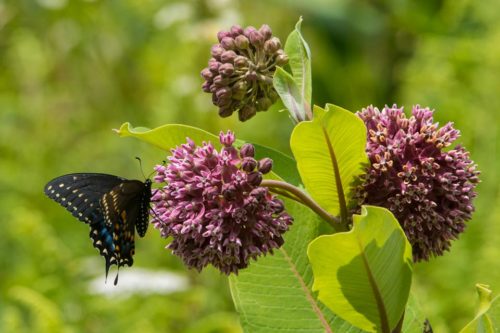NOTE: Shenandoah National Park/Skyline Drive is now open with some restrictions. Visit the park’s official website for full details.
According to George Gershwin, in summertime the livin’ is easy. Gershwin was right for the most part. In summer, not only are the fish jumpin’, but other fun conditions also prevail, including balmy weather and lots of sunshine. Summer hiking is a great experience.
Summer is a fantastic time to hike in Shenandoah National Park. There are wildflowers by the score and butterflies to watch. Birds are fun to watch, too, and plentiful in summer. Waterfalls and streams are fine destinations in summer’s heat. Fishing – perhaps the ultimate summer pastime – requires a hike to a stream, and can be a very pleasant way to spend a hot day.
Amidst all the splendor of summertime in Shenandoah, though, it’s easy to forget about the stuff that’s potentially not so much fun – dehydration and heat exhaustion, ticks, thunder and lightning storms, and tumbling over waterfalls when you’re not the water. Fortunately, a little extra planning is all you need to have a fun and safe hike in Shenandoah.
First, you’re going to need a good map. Detailed topographic maps are for sale at visitor centers. You can also view and download area maps from the hiking pages of the Park’s website ahead of your visit. Shenandoah’s trails are well maintained and clearly blazed; trail intersections are well marked. But you still need a good map, even for shorter hikes, as it’s easy to get turned around if you don’t know where you’re going. Stop by a visitor center and talk with a Ranger for hiking suggestions.
Even though it’s generally 10 to 15 degrees cooler in the mountains of Shenandoah than in the valley below, it still gets quite hot, and it’s usually humid in the hollows. Bring plenty of drinking water, at least a quart per hour per person. And don’t forget water for your pet! Pack plenty of high-calorie snacks, to help prevent exhaustion both regular and heat related. You cannot expect to get to the tops of summits, climb over boulders, or make it out of hot, humid hollows without proper body fuel.
Be Prepared
Shenandoah is home to ticks and so “Know your enemy” is sound advice for Park hikers, especially in summer. Ticks constitute more of a threat to visitors than larger, seemingly more menacing creatures. Be sure to check yourself thoroughly for ticks at the end of each day.
The Blue Ridge Mountains, like the rest of the Eastern U.S., gets some dramatic summer thunderstorms and the lightning that often comes with them. Storms can crop up suddenly in summer here, especially in the afternoons. Keep an eye on the weather and pack rain gear. Be prepared to take cover during storms.
Waterfalls and streams are perhaps the best destinations for summertime hiking in Shenandoah. Sticking your feet into a mountain stream or splashing around at the bottom of a waterfall is a marvelous way to cool off in the middle of a long hike. Pack water shoes or old tennis shoes, as rocks on stream bottoms can be slippery and sharp. And don’t even think about climbing waterfalls or crossing streams at the tops of waterfalls! This is simply one of the most dangerous, potentially deadly things you can do in the Park.
Don’t let safety considerations keep you from hiking some of the Park’s 500-plus-miles of trails. Be safe, smart and prepared. Then get out on the trails and have a great summer!
Written by Patressa Kearns
